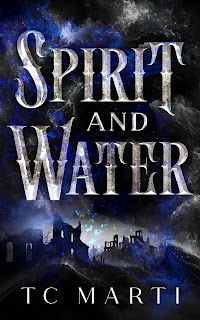

Third Chronicles of
Illumination
by C.A.
Pack
Genre: YA Paranormal/Fantasy
Release date: February 7th 2017
Artiqua Press
Summary from Goodreads:
In book eight
of the Library of Illumination where books literally come to life, a silent
"Oops!" hangs in the air. Teenagers Johanna Charette and Jackson Roth
have allowed a sneaky shapeshifter to slip right through their fingers. The
good news is: he’s now trapped between the layers of time and space with their
Terrorian nemesis, Nero 51. The bad news is: the Terrorian still wants to
control all the Libraries of Illumination, while the shapeshifter wants to
dominate everything else, and they’re doing everything possible to break free
of their constraints.
Who knows how long the Illumini system will remain safe? It’s taking a toll on
Johanna and Jackson, who are smack in the center of everything as they struggle
to protect the libraries’ legacy. Can you spell s-t-r-e-s-s? The pressure is
driving a stake between the teens, and their mercurial romance could be over
before it has truly begun.

Second
Chronicles of Illumination on Goodreads
Guest Post:
If I could go back in time…
It’s difficult to pick a single
point in history to visit when there are so many amazing people and events to
choose from. In the Third Chronicles of
Illumination, Johanna opens Victor Hugo’s Les Misérables, which is about a student uprising in
early 19th century France, and she asks Inspector Javert to ‘guard
the portals.’ In an earlier book, she and Jackson called on Albert Einstein for
help to determine whether a strange blue orb that suddenly appeared in the
library was a bomb. The teenage curators also have an ongoing relationship with
Merlin the Magician. Sadly, though, the closest they ever got to Leonardo da
Vinci was when Jackson opened one of da Vinci’s workbooks causing Vitruvian
Man to rotate over the information desk.
So, if I could go back in
time, I’d go back to the Renaissance in Florence and pick da Vinci’s brain. The guy was amazing.
He wasn’t only an artist and sculptor; he was a researcher and an engineer. Think
about it. The aforementioned sketch, Vitruvian
Man, was drawn in the late 15th century, yet it’s popular today
as a skin for cell phones and a cover for artsy journals.
I’m
no da Vinci, but I can relate to all his notebooks because I also have a habit
of keeping journals filled with my musings and sketches of things that pertain
to my writing. I have floorplans for the Library of Illumination and mind maps
of Merlin the Magician’s origins to help me establish my storylines. I’ve made
sketches of bombs, and what the residents of other worlds might look like to
help me with my books. So, I’d like to ask da Vinci what his tips and tricks
were for keeping everything organized, since he kept such prolific notes.
He
designed war machinery 400 years before similar models were actually made. He
studied anatomy and musculature, probably to aid him in painting people with
precision. A British art critic once said, da Vinci’s studies of the human
body, if released during his lifetime, might have changed the “course of
science.” Da Vinci could have published
his work. Gutenberg’s printing press had already been invented, so a book by da
Vinci could have been widely distributed, if he wanted it to be. But da Vinci’s
studies weren’t published during his lifetime. The Codex Atlanticus—a collection of his work—wasn’t published until
nearly a century later.
I
think da Vinci lived in the moment, studying whatever
captured his imagination on any given day. Maybe he had an immortality complex.
He might have thought he had all the time in the world to release his work. Or perhaps
he was a time traveler. Could he have visited the early 20th
century, and brought the imagery of war machines and airplanes back to 15th
century Italy? If only that were true, it’s a shame he didn’t also study motion
picture cameras. I think the artist would have been an astounding filmmaker.
During
my trip back to the Renaissance, I’d love for da Vinci to take me on a tour of
Florence; maybe wangle us invitations to visit some of the Medici family
palazzos, or even take me to see his "supposed” workshop at the Santissima
Annunziata Monastery. I would probably pass on watching him actually dissect of
a prison cadaver, though. I doubt I would find that appealing. On the other
hand, I wouldn’t mind hanging out at the Piazza della Signoria while he draws
sketches of various people’s noses. As a former art major, I would find that
interesting. Maybe he would even allow me to watch him paint the Mona Lisa.
There
might be a few setbacks in visiting the Renaissance period. I don’t know if I
could get used to public toilets. Florence can be pretty hot in the summer and
I would miss air conditioning. And how was da Vinci able to fire up his brain
to come up with so many inventive ideas when there weren’t any Starbucks? It
gives new meaning to the saying: “It’s a nice place to visit but I wouldn’t
want to live there.”
The
Renaissance ushered in advancements of science and technology, art and
literature, however, it would take another four centuries before anyone (or everyone)
could tweet about its awesomeness.
About the Author
C. A. Pack is the author of
the Library of Illumination series of YA paranormal fantasy
novelettes, along with Chronicles: The Library of Illumination (2014), The
Second Chronicles of Illumination (2015) and The Third
Chronicles of Illumination (2017).
Pack also writes for a general audience. Her first novel, Code Name:
Evangeline—is an historical spy thriller which takes place in the 1930's.
The author followed it up with Evangeline's Ghost—a fantasy about
the death of that same spy. She recently completed work on Evangeline's
Ghost: Houdini, and is currently working on Evangeline's Ghost: The
Bridge.
Pack is an award winning journalist from New York who worked as an
anchor/reporter and educator (she considers herself the fairy-godmother of
telvision news reporters)—and has written for WNBC, LI News Tonight and News 12
Long Island. She also worked on PBS documentaries, radio and television
commercials and created and produced a pilot for a news show focusing solely on
marriage and wedding trends.
She's a past president of the Press Club of Long Island and a proud member of
International Thriller Writers and Sisters in Crime. Pack has been a speaker or
panelist for organizations such as Women in Communications, Fair Media Council,
and the Society of Professional Journalists.
The author lives with her husband and two picky parrots “on” Long Island, New
York.
Author
Links:




























































.jpg)










0 comments:
Post a Comment